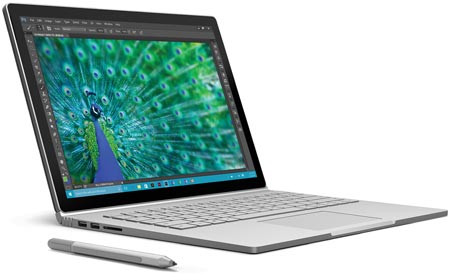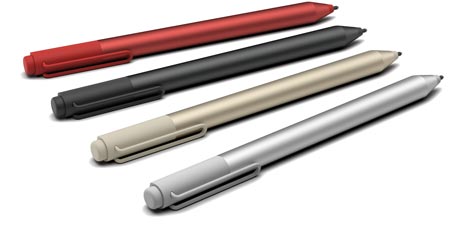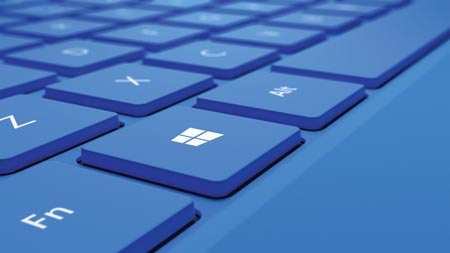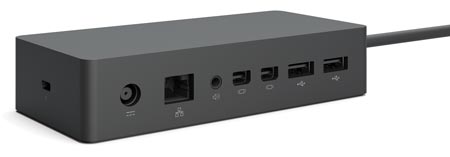In-Depth
Hands-On with the Surface Pro 4 and Surface Book
Our breakdown of the new Surface Pro 4 and Surface Book will help you decide if either or both should be on your wish lists.
As you begin shopping for new Windows 10-based portable PCs to roll out to your employees or perhaps you want to give yourself or a loved one a holiday gift, you'll find an interesting set of choices. Microsoft's surprise launch of the Surface Book in October has arguably upped the threshold of what will make an ideal laptop for mobile users and cast a bit of a shadow over the new Surface Pro 4. Will the new Surface Book emerge as the most prestigious laptop available? It's too early to tell but so far it doesn't appear destined to sell in large volume, at least from the outset. That's not to suggest it'll be a flop, especially as Microsoft makes improvements along the way.
At first glance, the Surface Book is the slickest and most powerful Windows laptop introduced to date for business users. Its magnesium casing and high-tech design featuring a novel flex hinge and an ultra-high-resolution touch-based display will be the system all others are compared with for now and likely imitated in the future. While Microsoft has created some buzz for the new Surface Book, it also comes with a price tag that will give customers sticker shock.
Even if you're contemplating breaking the bank for the Surface Book, consider your needs first and determine whether you want it for vanity reasons or if it's something that you'd benefit from using. The Surface Book certainly can satisfy some compelling uses -- both industrial and personal -- and offers configuration options and performance that outpace the Surface Pro. But the Surface Pros are lighter and that makes a big difference to many travelers or for those who carry their system around frequently. While the Surface Pros are no bargain, they're less expensive than the Surface Book.
If neither fits your needs, there are dozens of brand-new systems coming onto the market from the likes of Dell Inc., Lenovo, Acer, Toshiba and the newly divested HP Inc., among several others (see "PC Vendors Launch Systems Optimized for Windows 10" for a roundup of a few comparable business options). With comparable configurations and specs, they'll usually come in about 10 percent less expensive, give or take.
Even though Microsoft's hardware has become profitable, the company insists it's not doubling down on its Surface business to squeeze out traditional PC suppliers, a likely reason the Surface portfolio isn't priced to undercut them. Rather, the Surface effort aims to showcase the best of what's in Windows 10. Explicitly Microsoft is trying to push third-party OEMs to deliver more innovative devices.
"Our goal is to clearly have a vibrant ecosystem" Nadella said on stage with Dell Inc. founder and CEO Michael Dell in the keynote session at the October DellWorld conference in Austin, Texas. At the same time, Dell and rival HP took the unusual step this summer of agreeing to resell Surface Pro to their largest enterprise customers through their respective direct sales forces and consulting organizations (leading PC provider Lenovo reportedly balked at reselling them).
Why would Dell and HP want to sell products that would cannibalize their own offerings? Dell argued he doesn't see the Surface as a threat. "When I look at what Microsoft is doing with Windows 10, and the Surface Pro, what they are doing is pushing Windows 10 into new spaces, and driving the platform forward," he said in an attempt to justify the unusual arrangement. "I'm actually excited about that. The reason I'm excited: it's helping drive the Windows 10 ecosystem faster." Nevertheless, Dell doesn't see the number of Surface Pros sold coming near that of his own company's PCs, saying: "The volumes are not very high, the prices are pretty high, but it's great."
The Surface Book
The launch of the Surface Book came as a surprise at a New York launch event for Microsoft Windows 10 hardware lineup, when Corporate VP Panos Panay introduced it. Unlike the long-anticipated Surface Pro 4 that was expected to be the main event, no rumors had leaked indicating that Microsoft had a full-fledged laptop in the works. Consequently, the Surface Book stole the show.
 The Surface Book is Microsoft's first laptop.
The Surface Book is Microsoft's first laptop.
 The new Surface Pen can handle 1,024 levels of pressure and is available in multiple colors.
The new Surface Pen can handle 1,024 levels of pressure and is available in multiple colors.
Microsoft coins the Surface Book as the "ultimate laptop" because of its ultra-modern design based on a magnesium case and novel dynamic fulcrum hinge that resembles a flexible straw. Aimed to supersede the Surface Pro as its premium system offering, the Surface Book is suited for power users, graphic designers, engineers and even gamers. Thanks to its optional NVIDIA GPUs and 13.5-inch display that can render a crisp 6 million (3000x2000) pixels at 267 DPI, Microsoft argues it's superior to the Retina display on the latest MacBook Pro.
 The hinges give the Surface Book its distinct design.
The hinges give the Surface Book its distinct design.
In addition to sporting the latest Intel Corp. 6th Generation Processors, code-named "Sandy Lake," the Surface Book, while designed as a laptop, lets the user release the display and use it as a tablet. Because it's so thin in tablet mode, Microsoft had to leave the USB and other ports on the keyboard. If you're going to need to use any of those ports when using it as a tablet that should be a consideration, but for most that probably won't be a deal-breaker.
Microsoft is hoping the fact that the Surface Book has the detachable display and is touch-enabled, along with the included Surface Pen that can handle 1,024 levels of pressure sensitivity will win over MacBook Pro users. That may be wishful thinking, but if nothing else perhaps it'll prevent Windows users from jumping on the MacBook Pro bandwagon. "Microsoft needs to do everything in their power to show that Windows can hunt at high prices, particularly on the consumer side," says Patrick Moorhead, president and principal analyst with Moor Insights & Strategy in Austin, Texas.
David Sanders, a Microsoft MVP and president of the North Carolina Surface Users Group, was among those who spent a few days with the Surface Book at last month's MVP Summit. Sanders believes the Surface Book will appeal to large enterprises including one of the large national banks he works for as an IT manager. "I can see companies embracing this very quickly," Sanders says. "The price point may limit some academics from deploying in large numbers, but it would be perfect for the academic arena, more on the higher levels. It's also a great gaming machine and as Microsoft matures the Windows 10 platform and it deploys to Xbox, along with it will come the ability to game on it via Xbox streaming making it a de facto console for multiple gamers. So I think that may be a market that will boost it."
 A new keyboard has thicker keys with better travel.
A new keyboard has thicker keys with better travel.
However, based on early reviews, there are plenty of issues judging from critics who have shared a number of common complaints.
It weighs 3.34 pounds, which feels a tad heavy by today's standards, though if you're replacing a 5-pound clunker, that might be a moot point. It certainly feels heavy for a system with a 13.5-inch display, especially after picking up a new Surface Pro 4, which is 50 percent lighter. Some of the new alternatives from third parties have systems that weigh nearly the same, while others debuted devices that are a half-pound lighter.
Having only spent an hour with the Surface Book in Microsoft's offices, followed by a few visits to my local Microsoft Store, I can only say despite an impressive display and nicely lit keyboard, it's clearly much heavier than devices in its class.
And then there's the price. A bare-bones system will cost $1,499 (with only 4GB of RAM and a 128GB SSD) but prepare to spend closer to $2,000 or as much as $2,700 for a fully configured system.
Many early reviewers and customers have complained that the Surface Book is prone to frequent freezing and system crashes, though a firmware update is said to have resolved that issue. Perhaps the largest complaint is that it isn't achieving the 12-hour battery life Microsoft claims. Granted, mileage often varies on devices when it comes to battery life -- a more reasonable expectation appears to be in the 9-hour range.
Vladimir Mazek, an MCP, MCSA, MCSE and the systems administrator who runs OwnWebNow.com, ExchangeDefender.com and TheOfficeServer.com returned his Surface Book after spending a week with it. Besides the constant aforementioned crashes, Mazek, who is a self-described Microsoft evangelist, complained of its ergonomics in a review he posted on his own site Vladville.com last month: "Surface Book doesn't feel like a notepad," he lamented. "You need to use both hands to pry it open and even then it's not really easy."
MVP Sanders is more impressed, rating it a 9.1 out of 10. "I was very hard-pressed to find anything that I could call a flaw," says Sanders, who likes the construction of the device, especially the keyboard. "The tactile feel and operation of the keys are dead on perfect [and the] the new glass touchpad has precision that I have never experienced on a laptop before," Sanders, in a write-up he offered to Redmond says. One thing he did complain about regarding the keyboard was the backlit function, which tends to go dark when there's even slight lightness in a room.
"In darkened conditions where light is slight, the keyboard is great," he says. "However, in semi-dark conditions, the flat angle of the keyboard doesn't allow full lighting of all the keys -- at least for me -- and it requires that you lean in closer to the screen to see the keys properly. If you're a touch typist, this isn't an issue, but since I am not, it's a slight annoyance."
Sanders says that operation of the Surface Book is seamless across apps, though like many critics he was among those to note battery life was way below advertised. "I was able to get just under 8 hours of semi-continuous use and not the 12 I expected," Sanders says. "I have seen others reporting this issue, [along] with some conjecturing that the facial recognition feature [that enables Windows Hello] may be the cause. I have tried with bot the feature engaged as well as disabled and have gotten pretty much the same performance both ways." The weight is notably heavier than the Surface Pro 4, Sanders says. Despite its flaws, Sanders believes those looking for a powerful and well-constructed laptop will find it appealing.
Surface Pro 4
If you were impressed with the 12-inch Surface Pro 3 last year (see "First Look: Surface Pro 3"), clearly the thinnest and lightest ultraportable 2 in 1 PC-tablet, you'll be even more captivated by the company's follow-up. By incorporating a thinner bezel, the Surface Pro 4 sports a 12.3-inch, 10-point multipoint display compared with its predecessor's 12 inches. Physically the size is the same; merely more real estate was given to the display.
The Surface Pro 4 is slightly thinner (.33-inches compared with .36-inches) and lighter, weighing 786 grams compared with 800 for its predecessor. But the true allure of the Surface Pro 4 is the fact that it has a 2736x1824 resolution, or 267 pixels per inch (PPI) compared with the 216 PPI rendered by the previous version.
The Surface Pro 4 gets a 30 percent performance boost and is available in more configuration options. For example, the popular configuration that came with an Intel Core i5 processor, 256GB SSD drive and 8GB of RAM is now available with an optional 16GB, as well, and for those opting for a system with an Intel Core i7 processor can get a hefty 1TB SSD. Also, those on a tight budget can now select either a system with an M3 processor with 4GB of RAM and a 128GB SSD for $899 or a similarly configured device with an i5 processor for $100 more.
Microsoft says the system gets the same 9 hours of battery life, though Moor Insights & Strategy's Moorhead, who has spent several weeks with the Surface Pro 4, says it appears to get better battery life than its predecessor. "It gets at least a couple of hours more," he says, adding it's surprising, given the configuration. "SkyLake is a better chip, but they focused on 15 watts, which is higher, so I don't know where it's coming from," Moor says. "Maybe it's a better software load. It definitely feels more powerful graphically. Though I haven't run any official benchmarks the SkyLake graphics are demonstrably better than its predecessor."
The Surface Pro 4 also gains a 3D camera to take advantage of facial recognition to authenticate users using the new Windows Hello feature in Windows 10.
Microsoft introduced a new keyboard (sold separately for $129) that's clearly sturdier than the one offered with the Surface Pro 3. Notably it has keys that are more widely spaced that offer better travel and, overall, feels more solid. Indeed, it offers a much better typing experience. It's arguably the most important improvement Microsoft made with the Surface Pro 4, especially if you do a lot of typing on the system, where it offers a much better experience. It also has a wider and more responsive track pad.
Perhaps the best news is the new keyboard is backward-compatible with the Surface Pro 3. Frankly, if the Surface Pro 3 is still serving you or your users well, swapping out the keyboard will make you feel like you received a new system. Microsoft also introduced a second keyboard equipped with a fingerprint reader. That will especially appeal to Surface Pro 3 users because the older system's camera isn't able to implement the facial recognition feature offered in Windows 10. Having added that keyboard to the Surface Pro 3, it's a pleasure to not have to enter a password when accessing Windows.
The new Surface Pro 4 electronic pen offers a much more natural writing experience, thanks to its support for 1,024 pressure sensitivity levels, compared with the previous 256. The pen comes with the Surface Pro 4 and instead of connecting to an adhesive loop that attaches to the keyboard, it's magnetic, which means it can stick to the side of the device. Moorhead, among others, has complained that while the idea was a good one, the magnet isn't strong enough and you run the risk of it detaching, especially if it's in a bag.
The new Surface Pen also works with the Surface Pro 3 and can be purchased for an extra $60.
 The new docking accessory has four USB 3 ports, a miniDispay interface and a Gigabit Ethernet connector.
The new docking accessory has four USB 3 ports, a miniDispay interface and a Gigabit Ethernet connector.
The Surface Dock
One accessory that works with the latest two Surface Pros and the Surface Book is the new Surface Dock. It's a much simpler and more compact port replicator that gives any of those devices four extra USB 3 ports, two DisplayPorts enabling dual external monitors, audio output and support for a Gigabit Ethernet connector. Microsoft purposely made the compact unit heavy, 1.2 pounds, to protect it from falling off a desk, than potentially taking everything with it. It costs $199.